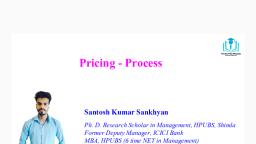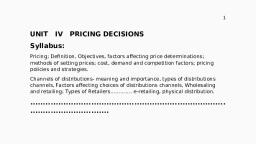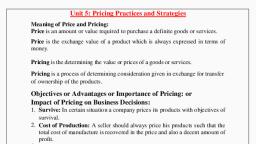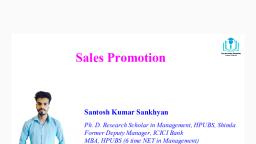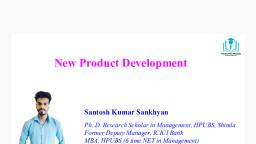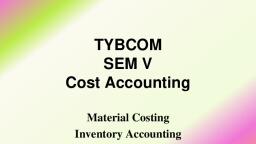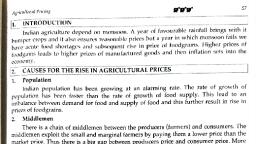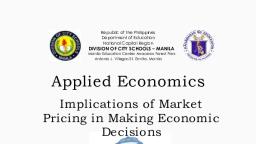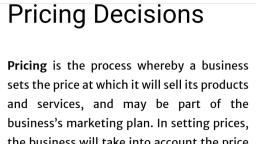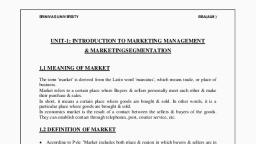Page 2 :
Handwritten Notes, Paper 1, , Paper 2, (Management), , Soft Copy, , ₹ 100, , ₹ 300, , Hard Copy, , ₹ 150, , ₹ 450, , Call or Whatsapp for Notes : 7627096162, Note : Paper 1 includes 7 units except Comprehensions, Numerical Reasoning, and Data Interpretation because these units are practice based and theoretical, part of these units is covered in notes., For hard copies postal/courier charges are separate.
Page 3 :
Pricing Methods, There are six price-setting methods : Markup Pricing, Target-Return Pricing, Perceived-Value, Pricing, Value Pricing, Going-Rate Pricing, and Auction-Type Pricing., A. Markup Pricing : The most elementary pricing method is to add a standard markup to the, product’s cost. Construction companies submit job bids by estimating the total project cost and, adding a standard markup for profit., Markups are generally higher on seasonal items (to cover the risk of not selling), specialty items,, slower-moving items, items with high storage and handling costs, and demand-inelastic items, such, as prescription drugs.
Page 4 :
Pricing Methods, B. Target-Return Pricing : In target-return pricing, the firm determines the price that yields its, target rate of return on investment. Public utilities, which need to make a fair return on investment,, often use this method., Suppose the toaster manufacturer has invested $1 million in the business and wants to set a price to, earn a 20 percent ROI, specifically $200,000. The target-return price is given by the following, formula :, Target-return price = unit cost + (desired return * invested capital)/unit sales
Page 5 :
Pricing Methods, C. Perceived-value Pricing : An increasing number of companies now base their price on the, customer’s perceived value. Perceived value is made up of a host of inputs, such as the buyer’s, image of the product performance, the channel deliverables, the warranty quality, customer support,, and softer attributes such as the supplier’s reputation, trustworthiness, and esteem., Companies must deliver the value promised by their value proposition, and the customer must, perceive this value. Firms use the other marketing program elements, such as advertising, sales, force, and the Internet, to communicate and enhance perceived value in buyers’ minds., D. Value Pricing : In recent years, several companies have adopted value pricing : They win loyal, customers by charging a fairly low price for a high-quality offering. Value pricing is thus not a, matter of simply setting lower prices; it is a matter of reengineering the company’s operations to, become a low-cost producer without sacrificing quality, to attract a large number of value conscious, customers.
Page 6 :
Pricing Methods, E. Going-Rate Pricing : In going-rate pricing, the firm bases its price largely on competitors’, prices. Smaller firms “follow the leader,” changing their prices when the market leader’s prices, change rather than when their own demand or costs change. Some may charge a small premium or, discount, but they preserve the difference. Going-rate pricing is quite popular. Where costs are, difficult to measure or competitive response is uncertain, firms feel the going price is a good, solution because it is thought to reflect the industry’s collective wisdom., F. Auction Type Pricing : Auction-type pricing is growing more popular, especially with scores of, electronic marketplaces selling everything from pigs to used cars as firms dispose of excess, inventories or used goods. These are the three major types of auctions and their separate pricing, procedures :, English auctions (ascending bids) have one seller and many buyers., Dutch auctions (descending bids) feature one seller and many buyers, or one buyer and many, sellers. In the first kind, an auctioneer announces a high price for a product and then slowly, decreases the price until a bidder accepts., Sealed-bid auctions let would-be suppliers submit only one bid; they cannot know the other bids.
Page 7 :
Pricing Strategies, Some price-adaptation strategies : Geographical Pricing, Price Discounts and Allowances,, Promotional Pricing, and Differentiated Pricing., A. Geographical Pricing : In geographical pricing, the company decides how to price its products, to different customers in different locations and countries., Barter : The buyer and seller directly exchange goods, with no money and no third party, involved., Compensation Deal : The seller receives some percentage of the payment in cash and the rest in, products., Buyback arrangement : The seller sells a plant, equipment, or technology to another country and, agrees to accept as partial payment products manufactured with the supplied equipment., Offset : The seller receives full payment in cash but agrees to spend a substantial amount of the, money in that country within a stated time period.
Page 8 :
Pricing Strategies, B. Price Discounts and Allowances : Most companies will adjust their list price and give discounts, and allowances for early payment, volume purchases, and off-season buying., Discount : A price reduction to buyers who pay bills promptly., Quantity Discount : A price reduction to those who buy large volumes., Functional Discount : Discount (also called trade discount) offered by a manufacturer to trade, channel members if they will perform certain functions, such as selling, storing, and record, keeping. Manufacturers must offer the same functional discounts within each channel., Seasonal Discount : A price reduction to those who buy merchandise or services out of season., Hotels, motels, and airlines offer seasonal discounts in slow selling periods., Allowance : An extra payment designed to gain reseller participation in special programs. Tradein allowances are granted for turning in an old item when buying a new one. Promotional, allowances reward dealers for participating in advertising and sales support programs.
Page 9 :
Pricing Strategies, C. Promotional Pricing : Companies can use several pricing techniques to stimulate early purchase., Loss-leader pricing : Supermarkets and department stores often drop the price on well-known, brands to stimulate additional store traffic., Special event pricing : Sellers will establish special prices in certain seasons to draw in more, customers., Special customer pricing : Sellers will offer special prices exclusively to certain customers., Cash rebates : Rebates can help clear inventories without cutting the stated list price., Low-interest financing : Instead of cutting its price, the company can offer customers low interest, financing., Longer payment terms : Sellers, especially mortgage banks and auto companies, stretch loans, over longer periods and thus lower the monthly payments., Warranties and service contracts : Companies can promote sales by adding a free or low-cost, warranty or service contract., Psychological discounting : This strategy sets an artificially high price and then offers the, product at substantial savings; for example, “Was Rs. 1000, now Rs. 999.”
Page 10 :
Pricing Strategies, D. Differentiated Pricing : Companies often adjust their basic price to accommodate differences in, customers, products, locations, and so on. Price discrimination occurs when a company sells a, product or service at two or more prices that do not reflect a proportional difference in costs., Customer-segment pricing : Different customer groups pay different prices for the same product, or service., Product-form pricing : Different versions of the product are priced differently, but not, proportionately to their costs., Image pricing : Some companies price the same product at two different levels based on image, differences., Channel pricing : Coca-Cola carries a different price depending on whether the consumer, purchases it in a fine restaurant, a fast-food restaurant, or a vending machine., Location pricing : The same product is priced differently at different locations even though the, cost of offering it at each location is the same., Time pricing : Prices are varied by season, day, or hour.
Page 11 : Thanks for Watching, Like, Comment, Subscribe and Share, , “The Unlimited Struggler”, , Contact Details :Email :
[email protected], Call & Whatsapp : 7627096162, (Hard/Soft copy of Hand Written notes also available on paid basis)









































